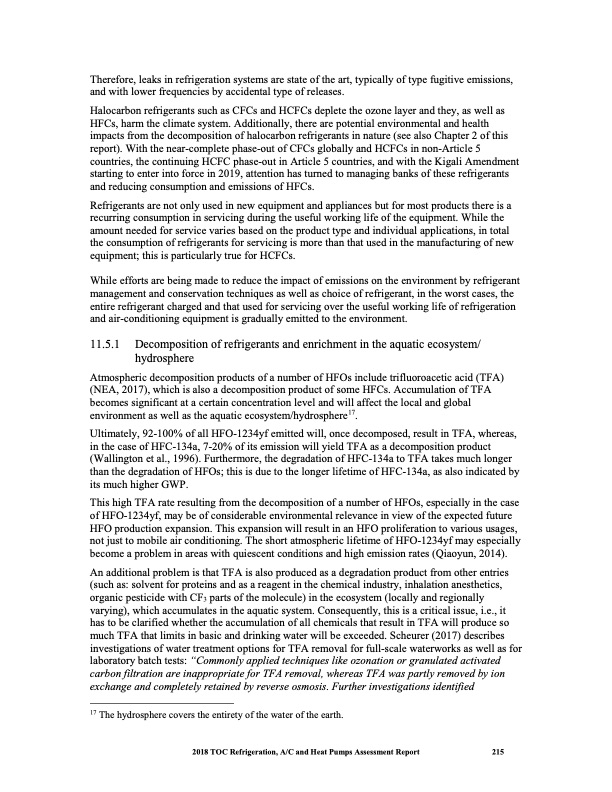
PDF Publication Title:
Text from PDF Page: 228
Therefore, leaks in refrigeration systems are state of the art, typically of type fugitive emissions, and with lower frequencies by accidental type of releases. Halocarbon refrigerants such as CFCs and HCFCs deplete the ozone layer and they, as well as HFCs, harm the climate system. Additionally, there are potential environmental and health impacts from the decomposition of halocarbon refrigerants in nature (see also Chapter 2 of this report). With the near-complete phase-out of CFCs globally and HCFCs in non-Article 5 countries, the continuing HCFC phase-out in Article 5 countries, and with the Kigali Amendment starting to enter into force in 2019, attention has turned to managing banks of these refrigerants and reducing consumption and emissions of HFCs. Refrigerants are not only used in new equipment and appliances but for most products there is a recurring consumption in servicing during the useful working life of the equipment. While the amount needed for service varies based on the product type and individual applications, in total the consumption of refrigerants for servicing is more than that used in the manufacturing of new equipment; this is particularly true for HCFCs. While efforts are being made to reduce the impact of emissions on the environment by refrigerant management and conservation techniques as well as choice of refrigerant, in the worst cases, the entire refrigerant charged and that used for servicing over the useful working life of refrigeration and air-conditioning equipment is gradually emitted to the environment. 11.5.1 Decomposition of refrigerants and enrichment in the aquatic ecosystem/ hydrosphere Atmospheric decomposition products of a number of HFOs include trifluoroacetic acid (TFA) (NEA, 2017), which is also a decomposition product of some HFCs. Accumulation of TFA becomes significant at a certain concentration level and will affect the local and global environment as well as the aquatic ecosystem/hydrosphere17. Ultimately, 92-100% of all HFO-1234yf emitted will, once decomposed, result in TFA, whereas, in the case of HFC-134a, 7-20% of its emission will yield TFA as a decomposition product (Wallington et al., 1996). Furthermore, the degradation of HFC-134a to TFA takes much longer than the degradation of HFOs; this is due to the longer lifetime of HFC-134a, as also indicated by its much higher GWP. This high TFA rate resulting from the decomposition of a number of HFOs, especially in the case of HFO-1234yf, may be of considerable environmental relevance in view of the expected future HFO production expansion. This expansion will result in an HFO proliferation to various usages, not just to mobile air conditioning. The short atmospheric lifetime of HFO-1234yf may especially become a problem in areas with quiescent conditions and high emission rates (Qiaoyun, 2014). An additional problem is that TFA is also produced as a degradation product from other entries (such as: solvent for proteins and as a reagent in the chemical industry, inhalation anesthetics, organic pesticide with CF3 parts of the molecule) in the ecosystem (locally and regionally varying), which accumulates in the aquatic system. Consequently, this is a critical issue, i.e., it has to be clarified whether the accumulation of all chemicals that result in TFA will produce so much TFA that limits in basic and drinking water will be exceeded. Scheurer (2017) describes investigations of water treatment options for TFA removal for full-scale waterworks as well as for laboratory batch tests: “Commonly applied techniques like ozonation or granulated activated carbon filtration are inappropriate for TFA removal, whereas TFA was partly removed by ion exchange and completely retained by reverse osmosis. Further investigations identified 17 The hydrosphere covers the entirety of the water of the earth. 2018 TOC Refrigeration, A/C and Heat Pumps Assessment Report 215PDF Image | Heat Pumps Technical Options

PDF Search Title:
Heat Pumps Technical OptionsOriginal File Name Searched:
RTOC-assessment-report-2018_0.pdfDIY PDF Search: Google It | Yahoo | Bing
CO2 Organic Rankine Cycle Experimenter Platform The supercritical CO2 phase change system is both a heat pump and organic rankine cycle which can be used for those purposes and as a supercritical extractor for advanced subcritical and supercritical extraction technology. Uses include producing nanoparticles, precious metal CO2 extraction, lithium battery recycling, and other applications... More Info
Heat Pumps CO2 ORC Heat Pump System Platform More Info
| CONTACT TEL: 608-238-6001 Email: greg@infinityturbine.com | RSS | AMP |